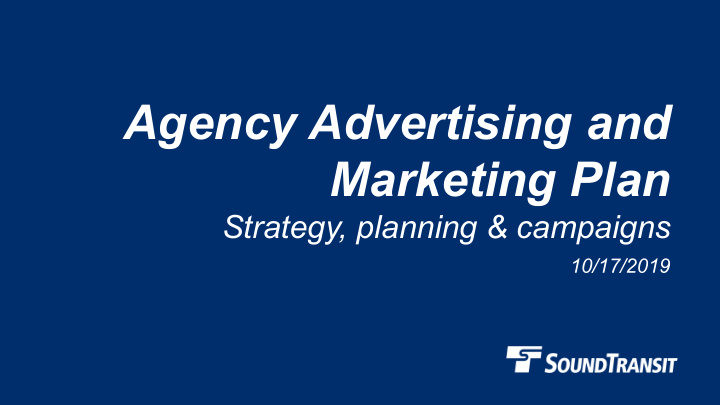



Agency Advertising and Marketing Plan Strategy, planning & campaigns 10/17/2019
Why we are here • Provide 2019 marketing plan overview • Review goals, audience & strategy for key business drivers • Provide information, no action is required 2
Sound Transit marketing program A multi-functioned division • Advertising (including sports partnerships) • Event marketing • Digital marketing (web/social/email) • Visual design for system expansion, rider information & signage, marketing • Video production 3
Why advertise? Investing in advertising and marketing : • Increases ridership • Increases brand awareness region-wide • Increases awareness of the value of public transit • Increases awareness of construction progress and system expansion 4
Consistent advertising budget for 6 years An average of no more than $1.3 million a year • Annual advertising budget has been $1.3 million for the past 6 years • Advertising budget represents less than 0.37% of the annual transit operating budget • ST ad sales revenues in 2018 was $1.7M $1.3M $1.7M AD BUDGET AD SALES REVENUE 5
Establishing a baseline of awareness Conducted an online survey this spring • Frequent, occasional & non-riders • Evaluated differences in awareness & perception Perceived benefits & opportunities for Sound Transit • Frequent riders are more likely to use Sound Transit for part of their commute, occasional riders are special event-focused • Favorability: Overall Sound Transit received the highest rating, second only to Washington State Ferries • One reason people cite for riding is they perceive Sound Transit as a “reliable form of transportation” 6
Unaided awareness indicators 36.7% 46.8% aware of aware of Link Sound Transit 7
Strategy & planning 2019
Goals based on business objectives Goal 1: Drive business results: Retain current riders & attract new ones • Strategy: Annual advertising campaign • Strategy: Transit to the game campaign • Strategy: Connect 2020 awareness 9
Building brand awareness & value Goal 2: Preserve & enhance Sound Transit’s reputation & support for public transit • Strategy: Professional sports partnerships • Strategy: Progress & value campaign 10
Campaign for Connect 2020 awareness November 2019 through March 2020 11
A focus on current and potential customers 1. Current customers 2. Potential customers: • “Leisure” riders (non commuters who could choose to ride transit during non-peak) • Tourists/visitors • People considering commuting by transit (most often triggered by a change – move, new job, etc.) 3. People who may not use transit, but pay for it 12
Media channel mix Video, including: Hulu, YouTube & cinema • Hulu • YouTube • Cinema Digital & digital audio • Pandora & Spotify, among others • Website ads • Facebook, Instagram & Twitter Outdoor: Sea-Tac Airport & transit Diversity, multi-language: print, digital & radio 13
Planning for the next 5 years 2020: Post-Connect 2020 • Goal 1: Attract and retain riders; focus on win-back strategies • Goal 2: Preserve & enhance Sound Transit’s reputation 2021: Northgate, Roosevelt & U-District stations open • Goal: Attract and retain riders; focus on bus-rail connections & ridership acquisition campaign • Strategy: Enhance Sound Transit’s reputation, focus on station opening activities 14
2021 - 2024: Ridership development Tacoma Link Hilltop, Eastlink, Federal Way, Downtown Redmond, Lynnwood & Stride BRT openings provide opportunities • New rider acquisition • Help current and new riders navigate transfers between bus & Link 15
Thank you. soundtransit.org
APPENDIX Annual campaign examples: Rider retention/awareness
18
19
20
Recommend
More recommend